The September 2011 monthly unemployment figures show the official unemployment rate remained at 9.1% and the total jobs gained were 103,000. 45,000 of those jobs are not new jobs, but Verizon workers who returned back to work after being on strike. Total private jobs came in at 137,000. If one subtracts off the returning strikers, September showed 82,000 new private sector jobs. Government jobs dropped -34,000.
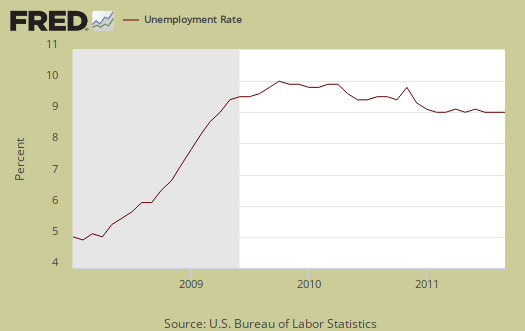
Below is the nonfarm payroll, the total number of jobs, seasonally adjusted. Since the start of the great recession, declared by the NBER to be December 2007, the United States has officially lost 6.65 million jobs. That does not take into account additional jobs needed to employ the United States increased population, but does include the jobs added over the over 3.75 years, or 45 month time period.
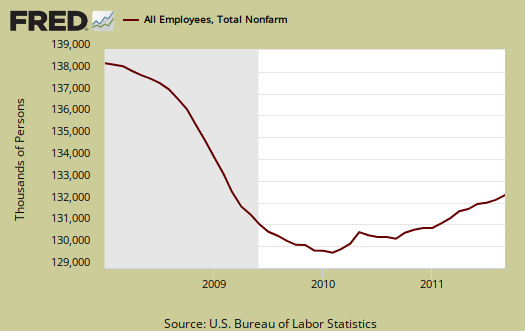
Below is a running tally of how many official jobs permanently lost since the official start of this past recession (recall the private NBER has declared the recession over!). This is a horrific tally and notice this isn't taking into account increased population growth, which implies the United States needs to create at least 10.5 million jobs or self-employment. This estimate assume a 62.7% civilian non-institutional population to employment ratio, as it was in December 2007, which implies an additional 3.85 million jobs needed over a 45 month time period.
If one takes the current civilian non-institutional population and the December 2007 to employment ratio and then subtracts off the current number of payroll jobs, the number of jobs to get to pre-recession levels is much worse, 19.2 million jobs. This doesn't take into account population subset fluctuations, for example, those retired percentages increasing. This isn't taking into account agriculture workers and self-employed, currently at 2.27 million and 8.33 million, respectfully. Bear in mind payrolls only counts nonfarm jobs and many people work 2 to 3 jobs to get by. Part-time workers are at record highs with 9.27 million of the 27.58 million part-timers working low hours because they cannot get full time jobs.
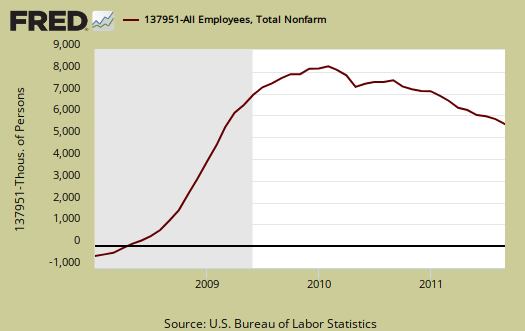
Striking Verizon workers, who are not really unemployed, made it into both the CPS and establishment surveys and were blamed for the big fat zero August job growth. What's happening here is payrolls jobs are within the margin or error, or job growth is so low, 45,000 workers can tip the monthly numbers. Without the Verizon workers, we're looking at only 58,000 new jobs for September. See Under the Hood for payrolls and employment statistics error margins details.
The increasingly low labor participation rate is now at 64.2%. If we go back to December 2007, the labor participation rate was 66%. The highest civilian labor participation rate was in January 2000, at 67.3%. What this means is there are over 4.32 million people not be accounted for in the official unemployment rate, in other words counted as employed or unemployed, who probably need a job and can't find one. That's in addition to the official 14 million unemployed.
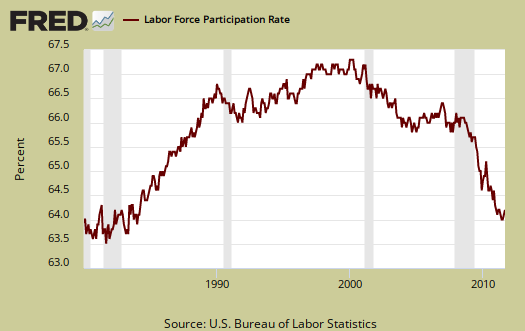
The employment to population ratio is now 58.3% which is at record lows. You have to go back to August 1983 to find such low ratios. This was when a severe recession occurred. The uber-low ratios are not a structural change, such as all families decided to have a stay at home caretaker, or magically a host of people could retire early, this is people dropping out of the count. They need a job, but stopped looking, fell off of the rolls, stop being counted.
These numbers are important because unemployment is a ratio, percentage or during a limited time period, the number of people actively looking for a job and counted. Many people are not counted in the official unemployment statistics, due to definitions, but obviously when one has more potential workers and less jobs, that metric doesn't bode well for America.
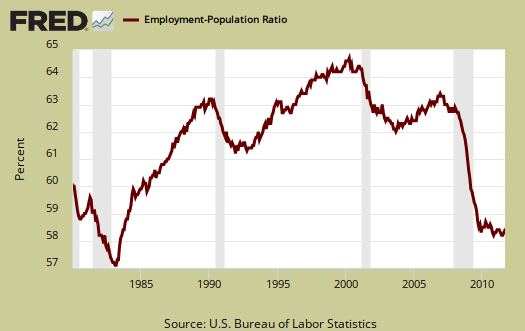
One needs at least 90,000 and some estimate up to 225,000 permanent full time jobs, added each month just to keep pace with U.S. civilian workforce population growth. That's not general population, that's the group needing a job.
January 2012 will finally incorporate the 2010 Census numbers for increased population in the BLS Household survey. Not only will this affect labor participation and employment to population ratios, but it will also give a improved non-institutional civilian population estimate, upon which calculations to figure out how many jobs are needed each month for population growth, are based.
Regardless, this unemployment report is dismal, like the monthly unemployment reports for the last 45 months. From the BLS Commisioner's Statement, we also have a increase in our dismal meter for the last 7 months:
Since April, payroll employment has increased by an average of 72,000 per month, compared with an average increase of 161,000 for the prior 7 months.
The United States has had a jobs crisis going on for over 45 months! Watch out for pundits trying to claim this is a good report, it's not.
Here is last month's unemployment report overview.

I know you wanted this "all in one", but.....
I'm having to break up articles on the unemployment monthly overviews. There simply is too much data for me to give analysis in one article in a timely manner and amplify the outrageous jobs situation that the data points to. I'll try to link up all of the articles into one "master" link. That said, these economic statistics overviews are organized into forums, in part so you can more easily look up recent data by forum category. (they are not forums really, but the format is set up so you can find them more easily).